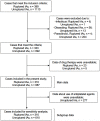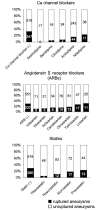Candidate drugs for preventive treatment of unruptured intracranial aneurysms: A cross-sectional study
- PMID: 33577580
- PMCID: PMC7880482
- DOI: 10.1371/journal.pone.0246865
Candidate drugs for preventive treatment of unruptured intracranial aneurysms: A cross-sectional study
Abstract
Background and purpose: Establishment of drug therapy to prevent rupture of unruptured intracranial aneurysms (IAs) is needed. Previous human and animal studies have gradually clarified candidate drugs for preventive treatment of IA rupture. However, because most of these candidates belong to classes of drugs frequently co-administered to prevent cardiovascular diseases, epidemiological studies evaluating these drugs simultaneously should be performed. Furthermore, because drugs included in the same class may have different effects in terms of disease prevention, drug-by-drug assessments are important for planning intervention trials.
Materials and methods: We performed a cross-sectional study enrolling patients diagnosed with IAs between July 2011 and June 2019 at our institution. Patients were divided into ruptured or unruptured groups. The drugs investigated were selected according to evidence suggested by either human or animal studies. Univariate and multivariate logistic regression analyses were performed to assess the association of drug treatment with rupture status. We also performed drug-by-drug assessments of the association, including dose-response relationships, with rupture status.
Results: In total, 310 patients with ruptured and 887 patients with unruptured IAs were included. Multivariate analysis revealed an inverse association of statins (odds ratio (OR), 0.54; 95% confidence interval (CI) 0.38-0.77), calcium channel blockers (OR, 0.41; 95% CI 0.30-0.58), and angiotensin II receptor blockers (ARBs) (OR, 0.67; 95% CI 0.48-0.93) with ruptured IAs. Moreover, inverse dose-response relationships with rupture status were observed for pitavastatin and rosuvastatin among statins, benidipine, cilnidipine, and amlodipine among calcium channel blockers, and valsartan, azilsartan, candesartan, and olmesartan among ARBs. Only non-aspirin non-steroidal anti-inflammatory drugs were positively associated with ruptured IAs (OR, 3.24; 95% CI 1.71-6.13).
Conclusions: The present analysis suggests that several types of statins, calcium channel blockers, and ARBs are candidate drugs for preventive treatment of unruptured IAs.
Conflict of interest statement
The authors have declared that no competing interests exist.
Figures



Similar articles
-
Effect of combined acetylsalicylic acid and statins treatment on intracranial aneurysm rupture.PLoS One. 2021 Feb 18;16(2):e0247153. doi: 10.1371/journal.pone.0247153. eCollection 2021. PLoS One. 2021. PMID: 33600491 Free PMC article.
-
Relationship Between Aneurysm Wall Enhancement in Vessel Wall Magnetic Resonance Imaging and Rupture Risk of Unruptured Intracranial Aneurysms.Neurosurgery. 2019 Jun 1;84(6):E385-E391. doi: 10.1093/neuros/nyy310. Neurosurgery. 2019. PMID: 30011026
-
Rupture risk of intracranial aneurysms: Comparison between small ruptured intracranial aneurysms and large unruptured intracranial aneurysms.Medicine (Baltimore). 2024 Jul 12;103(28):e38909. doi: 10.1097/MD.0000000000038909. Medicine (Baltimore). 2024. PMID: 38996146 Free PMC article.
-
Aspirin and growth, rupture of unruptured intracranial aneurysms: A systematic review and meta-analysis.Clin Neurol Neurosurg. 2021 Oct;209:106949. doi: 10.1016/j.clineuro.2021.106949. Epub 2021 Sep 17. Clin Neurol Neurosurg. 2021. PMID: 34562772
-
Potential role of aspirin in the prevention of aneurysmal subarachnoid hemorrhage.Cerebrovasc Dis. 2015;39(5-6):332-42. doi: 10.1159/000381137. Epub 2015 May 7. Cerebrovasc Dis. 2015. PMID: 25967073 Free PMC article. Review.
Cited by
-
Multiomic Underpinnings of Drug Targets for Intracranial Aneurysm: Evidence From Diversified Mendelian Randomization.CNS Neurosci Ther. 2025 May;31(5):e70430. doi: 10.1111/cns.70430. CNS Neurosci Ther. 2025. PMID: 40346920 Free PMC article.
-
Animal Models of Intracranial Aneurysms: History, Advances, and Future Perspectives.Transl Stroke Res. 2025 Feb;16(1):37-48. doi: 10.1007/s12975-024-01276-3. Epub 2024 Jul 26. Transl Stroke Res. 2025. PMID: 39060663 Review.
-
Associations Between Drug Treatments and the Risk of Aneurysmal Subarachnoid Hemorrhage: a Systematic Review and Meta-analysis.Transl Stroke Res. 2023 Dec;14(6):833-841. doi: 10.1007/s12975-022-01097-2. Epub 2022 Oct 15. Transl Stroke Res. 2023. PMID: 36242746
-
Genetically determined blood pressure, antihypertensive medications, and risk of intracranial aneurysms and aneurysmal subarachnoid hemorrhage: A Mendelian randomization study.Eur Stroke J. 2024 Mar;9(1):244-250. doi: 10.1177/23969873231204420. Epub 2023 Oct 6. Eur Stroke J. 2024. PMID: 37800876 Free PMC article.
-
Hypoxic microenvironment as a crucial factor triggering events leading to rupture of intracranial aneurysm.Sci Rep. 2023 Apr 4;13(1):5545. doi: 10.1038/s41598-023-32001-z. Sci Rep. 2023. PMID: 37015954 Free PMC article.
References
MeSH terms
Substances
LinkOut - more resources
Full Text Sources
Other Literature Sources
Medical

